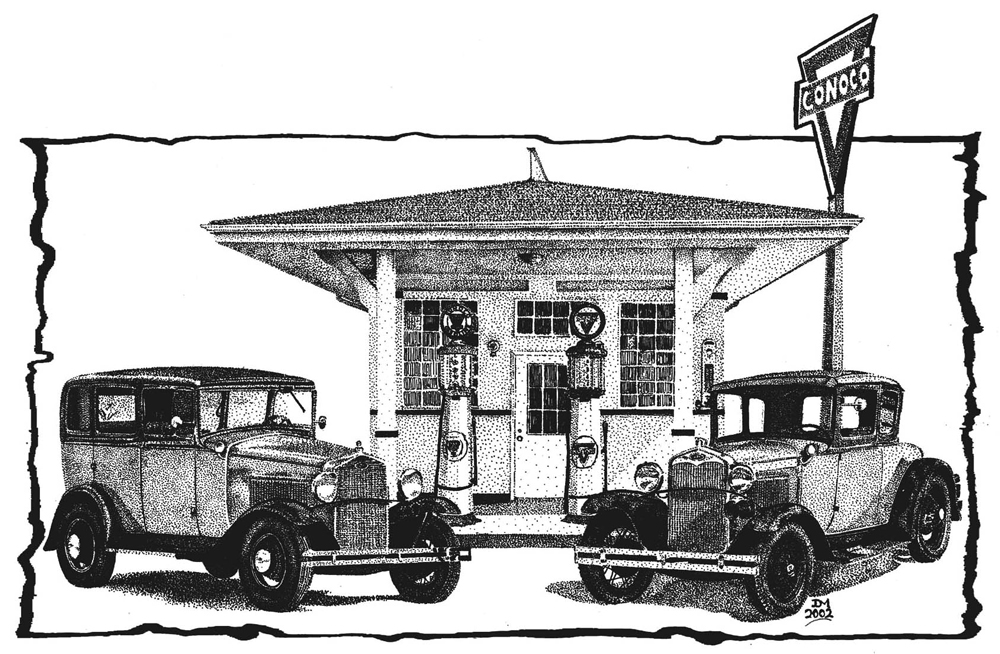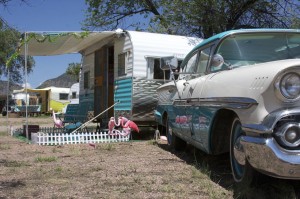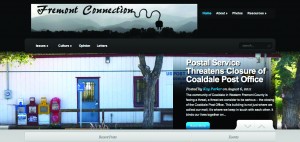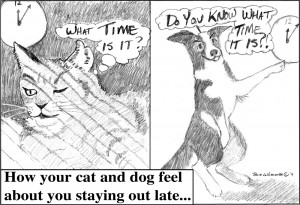By Jackie Powell
Filling stations. Service stations. Gas stations. Aren’t they all the same thing? Maybe and maybe not. But they have certainly changed since I was a child in the 1950s.
My father would drive into a gas station and the attendant would come out wiping his hands on a greasy red cloth. Full-time attendants wore a complete uniform – jacket and shirt with embroidered name and logo, slacks and cap. High school boys working part-time often only had a shirt with their name on it.
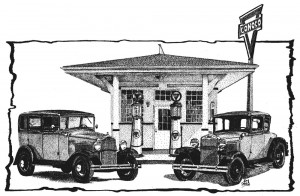
The attendant would bend down to look inside the car, touch the brim of his cap if he had one on, and say, “Good afternoon, sir, what can I do for you?” Daddy would say, “Fill ‘er up” or “Five gallons, please” or “A dollar’s worth, please.” Because gasoline went for twenty-five cents a gallon, a dollar’s worth might get you around until the next paycheck.
If we were on a road trip, my mother, brother, and I would spill out of the car to use the bathroom, get a drink of water, and maybe buy a cold drink from a red metal cooler full of ice. If we were lucky we could have a candy bar. Later, as gas stations became fancier, they were air conditioned, and we would stay inside as long as we could because the car was an oven in the summer.
The attendant would wind up the pump or, if it was electric, turn it on, and put the nozzle in the tank opening. He almost always cleaned the windshield. He would ask “Check under the hood?,” and if the answer was yes he checked the oil, the radiator and battery water. Daddy would pay for the gas, and the attendant would touch his hat again in good-bye.
As television came in, commercials advertised specific brands of gasoline and related auto products such as engine oil. Many of us remember “You can trust your car to the man who wears the star – Texaco gasoline!” The Texaco star appeared on the service station sign, on the pumps, and on the pocket of the attendant’s uniform. Free road maps had the Texaco logo prominently displayed.
A memorable Texaco commercial, considered quite racy at the time, showed a Texas cowgirl who stood facing the camera wearing a large Stetson, a shirt with a vest over it, and chaps. She’d drawl, “I lahk the waahd open spaces!” Then she’d turn around to reveal that she was wearing very short shorts under the chaps. Then the Texaco jingle would play. My father particularly liked that one. I think it was often shown during the Milton Berle show.
During the mid-1950s, full service gas stations were at their peak. There seemed to be one on just about every corner, and because almost every postwar family bought a car as soon as they could, gasoline sales became a highly competitive business.
But in the late 19th and early 20th centuries, selling gasoline was a small business operation. Gasoline arrived from the refinery at a bulk plant on the edge of town, often near the railroad. There, big raised tanks held the gasoline until it was loaded into tank wagons or trucks. The gasoline was then carried to a livery or repair shop, or to a home or store along the highway outside of town.
The gas was sold to motorists by the bucket or five-gallon gasoline can. It had to be strained through a funnel into the gas tank of the car to remove impurities. As late as 1925, fuel filters were optional equipment for cars, as were shock absorbers and headlights. It was a messy, smelly and dangerous process.
On the open road, motorists had to plan ahead to avoid running out of gas. A Kansan remembers driving to Colorado:
“Gasoline filling stations were unheard of. You picked out the best looking or sometimes the only garage in the town and they filled the car from five-gallon cans.”
By 1905, the “Filling Station” was invented by Sylvanus F. Bowser. It was a fuel pump that could be locked, and merchants could leave it outside at night. These filling stations were usually right at the edge of the traffic lane for the customer’s convenience. There might be a simple shed nearby to provide shelter for an attendant. The motorist would stop in the road, and the attendant would fill the car directly from the “filling station” and take the payment. Obviously this caused congestion, especially in towns.
In Colorado, automobiles moved quickly from luxuries to commonly used vehicles. The first automobile endurance race in Colorado was held in 1903, going from Denver to Colorado Springs. By 1909, the first state highway was funded and built, and in 1919 a state gasoline tax of one cent per gallon was enacted.
A search of the Salida City Directory for 1907-1908 and 1911-1912 showed no evidence of automobile sales or service, nor was there any sign of a place to buy gasoline. But autos were around, because The Fairplay Flume reported in 1908 that “Automobiles are plentiful around Alma at present; but how about the gasoline?”
Furthermore, the “See America First” campaign was underway nationwide in 1912. The philosophy was that people should go ahead and see Europe if they must, but they should see America first. Colorado encouraged tourism from the states southeast of us under the aegis of “See America First,” including along Highway 50:
A new automobile highway has been built along what was known as the old Santa Fe trail … which has been designated as part of the trans-continental highway. For miles and miles this highway is said to be as smooth as a city street. The route leads to Pueblo … thence to Colorado Springs and on to Denver.
When John D. Rockefeller’s Standard Oil trust was dissolved in 1911, corporate rivalry began. Companies began establishing gas stations that sold only their own brand of gasoline, and they developed marketing devices to lure customers, hoping to generate brand loyalty. In addition to standardized signs with the corporate logo, many companies designed a standardized station architecture that people would be able to recognize easily. Amenities were added to draw customers, such as restrooms – always advertised as being clean.
The 1913-1914 Salida City Directory lists at least four auto dealers in town. William E. Jurd, at his residence located on Poncha Road near K Street in Salida, was an agent for “Automobiles, Pianos, Sewing Machines and Repairing, 300 Candle Power Lamps, Steel Ranges and Farming Implements.” J.M. and F.E. Groves had the Rainbow Auto Company at 150 E. 1st. And there was even a place to rent cars: L.O. Young and Sons’ Ideal Auto Company at 341-343 West 3rd advertised, “Cars for sale. Auto livery. Anyone Anywhere Anytime. All repair work guaranteed” and “Agents for the Overland,” a brand of automobile. There still is no evidence of any place to buy gasoline, but it must have been around, perhaps still in those tanks next to the road or at the dealers and liveries.
There is a gap in the directories in the Salida Library, but by the 1922-1923 issue, there was a full panoply of automobile-related businesses – garages, gasoline and oils, machine works, storage batteries, tires and tubes. The White Auto Company was at 242 East 3rd St. The Salida Harness Company at 132 F advertised themselves as “Automobile Trimmers” and “Auto Top Mfrs.” The Ocean to Ocean Camp Ground, listed under Automobile Camps, was located at 404 Wood Ave., at Oak. By 1927 there was a filling station there.
By 1919 distributors were delivering gasoline to locations with large underground storage tanks. The pumps that drew from these were located away from the road, to allow parking space for customers. Sometimes, sheltering canopies extended from the building to the pumps. A photo of Third and F Streets in Salida from September 1926 shows the Continental Oil Company gas station at the northeast corner. It is a stucco building set diagonally on the corner, with a tile roof that extends over a canopy.
As filling stations became more common there was an effort to make them more attractive. Designs varied from Tudor, Colonial, or Spanish Colonial to ultra-modern. Sometimes they resembled small houses or cottages, such as the Phillips 66 stations built to a standard “Tudor cottage” plan, with steeply-pitched gable roofs. An example of one of these, now converted into a gingerbread-trimmed pseudo-Victorian house, can be seen at the corner of Seventh and Front Streets in Fairplay.
At the corner of First and G Streets in Salida, right next to the skate park, is a former gas station which was built around 1930. It is at an ideal location – on the corner of an important intersection, where customers could approach the pumps from either First or G Streets. This little building has lost many of the characteristics that made it a gas station, particularly the pumps, but it displays characteristics of a “pagoda style” standardized Pure Oil station. This was vaguely oriental in design, often with a red tile roof. It probably didn’t have a canopy, and it now has a composition roof. It shows up in a late 1930s photograph, at which time there was a wood and coal company between it and the Monarch Spur railroad tracks. Although it’s possible it was the office for the fuel company, it is likely that the fuel company operated it as a gas station.
Typically, filling stations included a small office area, storage areas, and public restrooms. Sometimes a canopy was extended from the front of the building, to provide shelter to customers. These “service stations” wanted to lure customers inside with auto-related products and public bathrooms and water coolers were installed and snack items and cold drinks were available.
Service bays were added, often connected to the gas station, at which point it became a service station. Routine auto maintenance was also available. What started as a shed had grown from mere shelter into a retail outlet.
At 205 W. 1st Street, just across the street from the “pagoda-style” station, is the Salida Service Station, an example of adding more services rather than simply selling gasoline. Built around 1927, R.K. Young was the proprietor. The north building was the office and, originally, the gas station. Directly south is the building – now Café Dawn – which was built later to house bays where service and repair were done. Early on, this might have been called a “lubritorium,” but that word never really reached common use.
This station offered tires, batteries, accessories, vulcanizing, greasing, and complete lubrication services. In the October 1927 “Booster Edition” of The Salida Mail, Salida Service Station pledged that “our modern tire shop is equipped to give you complete tire service and we guarantee every repair for the life of the tire.” It was still a gas station as late as 1983, when it was Kolbeck’s Gas Station.
The next stage in the gas station design was an emphasis on functionalism. Built of pre-fabricated steel and concrete block, sometimes with enameled metal veneer, these modern stations provided an office, service bays and a display area. These are the gas stations of the mid- to late 20th century.
Routine auto maintenance was available at these service stations. If it was a quick, minor task or they just wanted to take a look, an attendant might roll under the car on a little wheeled trolley. For more extensive work, they would drive it onto a hydraulic lift, then flip a switch to raise the car to a convenient height. Less affluent stations sometimes had a pit instead of a lift.
Today we drive up to the pump under an enormous canopy, flip the gas tank lid opener, step out, swipe our credit card, choose the octane we want and fill the tank. We get annoyed if we have to go inside to get a receipt. “Inside” is usually a convenience store where we have to wait in line behind people buying cigarettes, Twinkies, microwave burritos, lottery tickets and all the other convenient products these establishments sell.
All we need now is a way to swipe our card and get the hose into and out of the tank without getting out of the car. Maybe we just need attendants …
Jackie Powell has been enjoying road trips for longer than she can remember.
